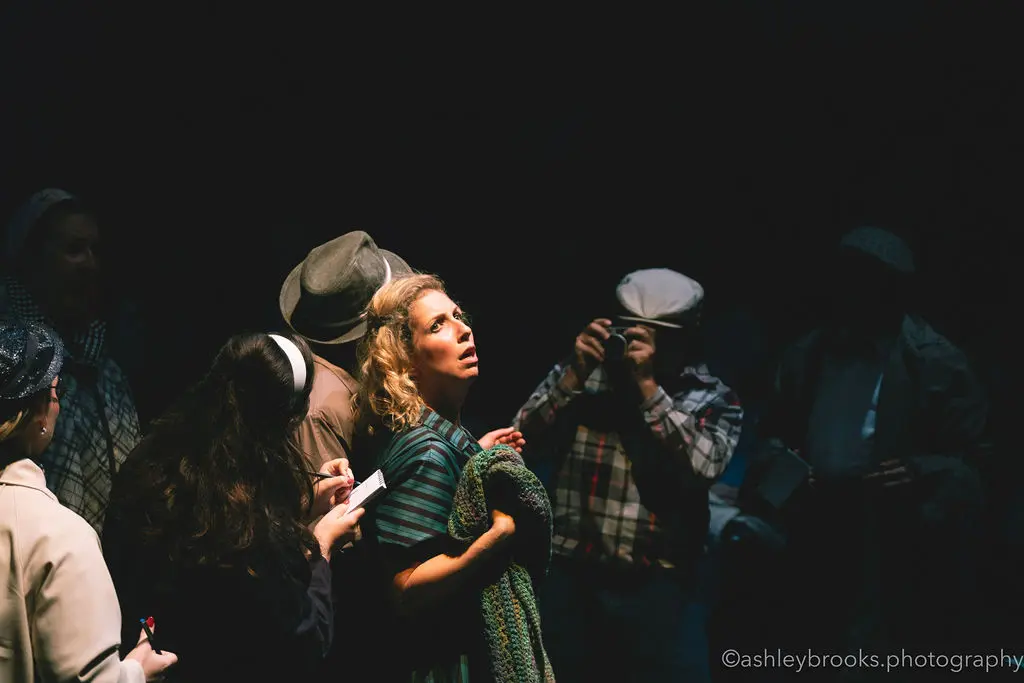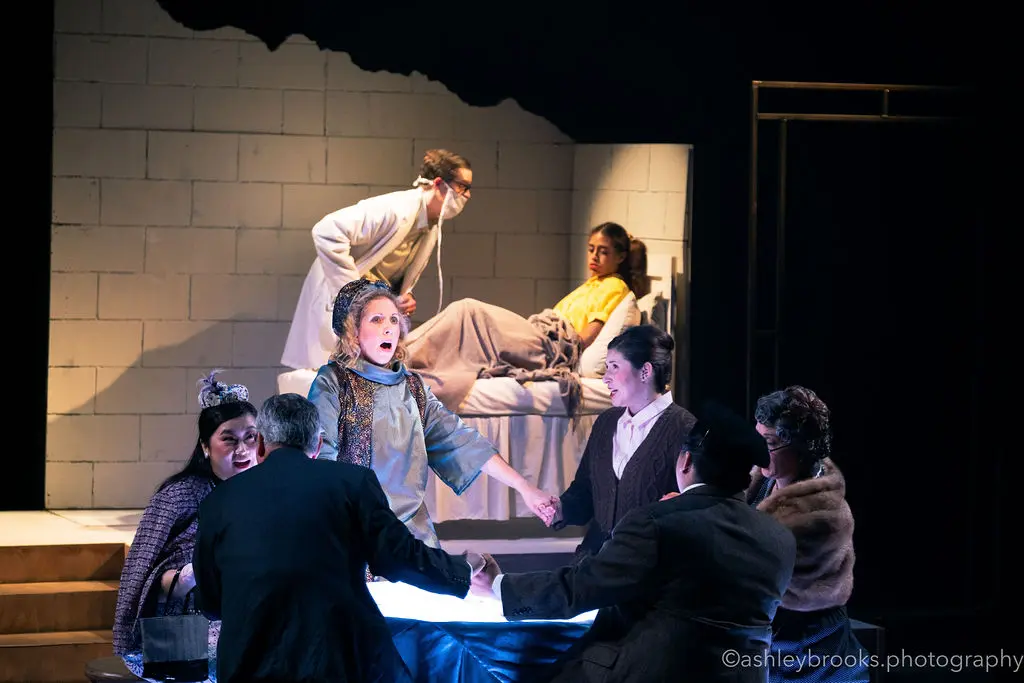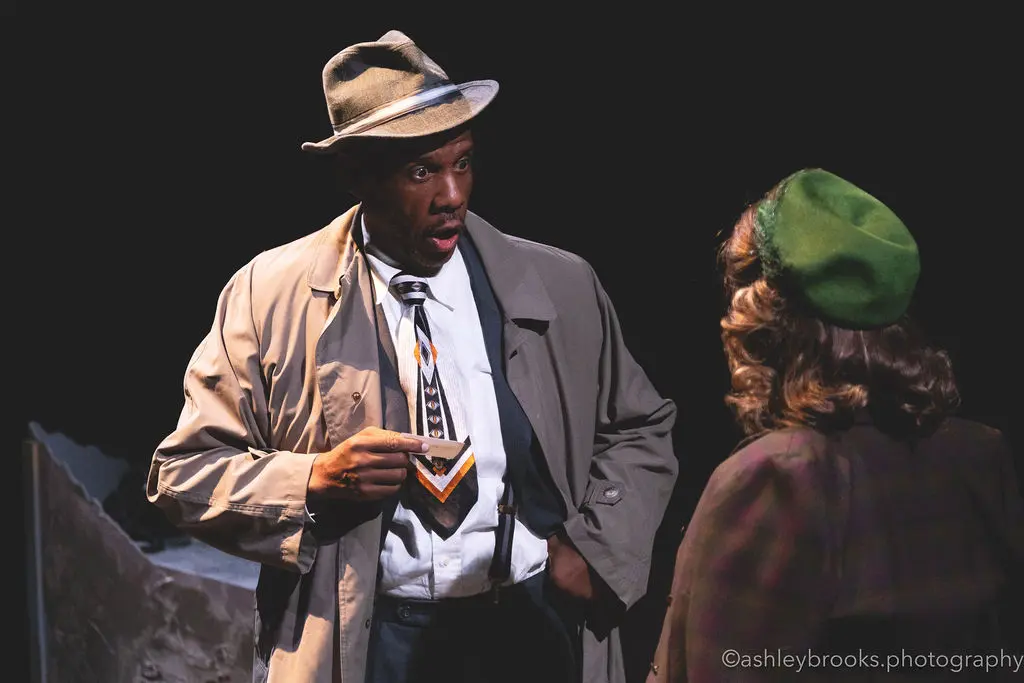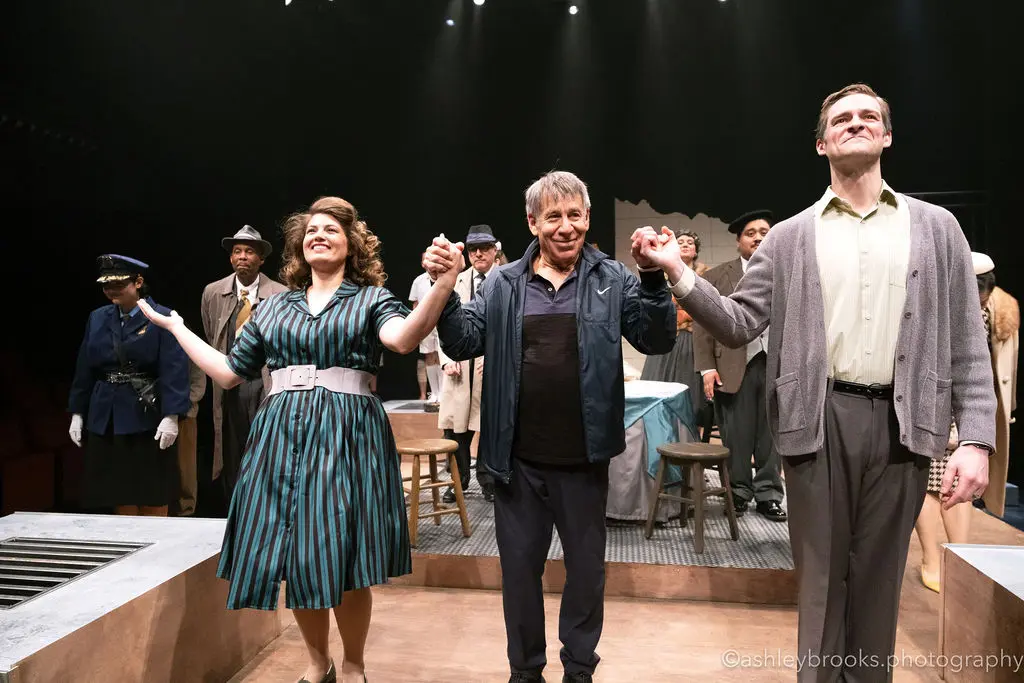Legendary Composer Of Wicked Teams Up With Houston’s Lone Star Lyric For An Unforgettable Séance
Stephen Schwartz Embraces a Smaller Stage
BY Adrienne Jones //John Arnold, Brennan Blankenship break into a scene in Lone Star Lyric's "Séance on a Wet Afternoon" by Stephen Schwartz (Photo by Ashley Brooks)
The Sterling Stage at The Gordy in Houston was abuzz with anticipation — not just for the opening notes of Séance on a Wet Afternoon, but because its creator, famed Broadway composer and lyricist Stephen Schwartz (the man behind Wicked, Godspell and many others), was in the house for Lone Star Lyric’s revival of his only opera. The 250-seat theater was sold out, and when the lights went up three hours later, the audience was on its feet with one of the longest ovations I’ve ever heard.
Schwartz stayed on for the reception that welcomed the entire audience, posing genially for photos with fans of all ages. Equally as intriguing as his august presence were his remarks describing the production as an “experiment.”
The composer wanted to see how his 2009 contemporary opera would fare in a space smaller and less formal than a conventional opera house. If successful, a production like Lone Star Lyric’s Séance on a Wet Afternoon could reach broader audiences around the country.
“Séance on a Wet Afternoon is a very intimate story about the relationship between two people,” Schwartz says. “It seemed to me that it could play very well in smaller venues, where the audience could be closer to and immersed in the action, if practical in terms of cast and orchestra size.
“When Lone Star Lyric offered me the chance and resources to do a smaller version, I was happy to jump at it.”
He wasn’t the only one.
“After perusing the bounty of 20th-century operas by American composers for our 19th summer season,” Lone Star Lyric director and producer Kelli Estes writes in an email. “I realized many were on a scale too large for LSL. Quite by chance, I came across Séance and thought to myself, ‘Wouldn’t it be interesting to stage a séance in a thrust or arena-style theater?’ ”
After a few twists and turns, Estes notes, she found herself on a call “with THE Stephen Schwartz discussing a paired down orchestration and production.”

Many regional theaters have intimate spaces similar to Sterling’s, which has seating on three sides and a two-row balcony. And while Schwartz’s original production used an orchestra of 16 to 30 players, Lone Star Lyric pulled it off wonderfully with six musicians, who achieved a fine aural blend with the cast of five principal roles and a small chorus of reporters and town folk who appeared a handful of times.
The spectacularly virtuosic production was clearly triumphant. For Schwartz, the experiment was a success as well.
“The leading singers were not only superb vocally and in terms of their musicianship, but they were fantastic actors as well,” he says. “That’s a very rare combination to find. On top of that, the deceptively simple design and staging were also of the highest quality.
“I was hoping for a chance to see this smaller version of Séance done well enough to tell if it could work, and what I got exceeded my wildest expectations.”
American Contemporary Opera Meets Its Moment
American opera companies have been experiencing success with contemporary work relieved of palace intrigue, ancient myths and the stuff of traditional opera plots. New York Times opera critic Zachary Woolfe recently reviewed Des Moines Metro Opera’s productions of American Apollo, about storied portrait painter John Singer Sargent, and A Thousand Acres, based on Jane Smiley’s novel set in Zebulon County, Iowa.
Schwartz took the story for Séance on a Wet Afternoon from the 1961 novel of the same name by Mark McShane and the 1964 film starring Richard Attenborough, and developed it into a full-length opera. It opened in Santa Barbara in 2009 to audience support but mixed reviews, and then moved to New York City Opera in 2011 for a run of less than two weeks to neither box office nor critical success. There had been no major productions until Lone Star Lyric’s revival.
When Séance opened, 16 years and a generation of opera-goers ago, the genre of American contemporary opera was just finding producers and its way among audiences.

American contemporary opera is often defined as those written in English after 1970 with plots that explore recent historical events or social issues, and incorporate modern staging and technology. Philip Glass is probably its best-known pioneer, beginning in 1976 with Einstein on the Beach, followed by a prodigious output of some 20 full-length works culminating in 2014 with The Trial, based on the novel by Franz Kafka. Other seminal composers of that fledgling era are Thomas Adès (Powder Her Face, 1995) and John Adams (Nixon in China, 1987).
Since those earlier days, operas written by the Big Three of today’s contemporary opera — Terence Blanchard (Fire Shut Up in My Bones), Missy Mazzoli (Breaking the Waves) and Jake Heggie (Dead Man Walking) — have become hugely popular among older, sophisticated season subscribers, and provided critics with a rich new vein to write about.
Younger audiences are drawn to the storylines dealing with current issues and, musically, some even seek out atonal, minimalist, or experimental “post-tonal” works.
Schwartz’s work appeals on several of these levels. Finally, in 2025, Séance on a Wet Afternoon’s time has come.
Inside a Seance
Under Estes’ artful direction, the music never overpowered the singers’ strong voices, but didn’t fade away either. The volume didn’t blast the audience out of their seats. Instead, they were able to experience the magnificent, operatically trained voice of each cast member without the amplification many theatergoers have become accustomed to experiencing.
Schwartz says he is “eternally grateful” to music director and co-arranger Robert Hunt, who was charged with reducing the orchestra to the new, smaller size to fit in Sterling’s intimate space.
“Hunt jumped into the fray,” Schwartz says, “and did absolutely brilliant work.”

Set in the 1950s, the opera is a dark psychological thriller about grief, delusion and exploitation, told through the story of Myra, a troubled medium who holds séances in her home. She is aided by her husband Bill, who functions reluctantly as her assistant.
It becomes clear they are both haunted by at first one, and then two, tormenting secrets. The first has to do with a dead son Arthur. Myra speaks to him in the spirit world, but audiences are left to wonder whether Arthur ever existed or if he is simply a manifestation of grief or mental illness. The other secret is the monstrous scheme Myra concocts to kidnap a young girl and become famous by convincing the press and townspeople she has used her telepathic powers to “find” the child.
Myra and Bill enter into a folie à deux in which Myra’s obsession and entanglement with the occult drive her into moral ruin and madness, while her husband continues to enable her not just out of fear and moral paralysis, but a love that has become obsessive and destroys him as well. These are, of course, all themes — sometimes melodramatic, but nearly always tragic — that have been associated with grand opera for centuries.
“The central theme of Séance is the danger of wanting too much and even loving too much — wanting fame and glory so much it causes you to do bad things and loving someone so much it makes you go along with them,” Schwartz says.

As Myra, soprano Lisa Borik Vickers leads the cast and drives the production with her powerful voice and superb acting. Her cri de coeur in the haunting aria “Before You” displays her astonishing range, while the pathos in her nuanced portrayal left theater goers moved and reflective. The deftness of Vickers’ artistry is breathtaking to experience.
John Arnold’s star moment as Myra’s husband Bill, comes in Schwartz’s deeply affecting aria, “You Didn’t Know Her.” It is Bill’s emotional confession and lament for the woman he knew when they married. In his strong bass-baritone, Arnold carries off with stirring effect the subtle dissonances that reflect Bill’s inner torment.
Perhaps the most touching moment of the evening belongs to the powerful duet, “Adriana,” sung by soprano Riley Ortega as the mother of the kidnapped girl and tenor Brian Ross Yeakley as the father, expressing their grief over the disappearance of their beloved child. Yeakley’s radiant lyric voice, coupled with his psychologically acute acting, is nothing short of heartbreaking.
Also exceptional are the costumes by designer Alicia Moore Chew. They perfectly capture the style of 1950s America, especially the women’s tailored suits, hats, fur stoles. The era’s signature signifier — a brooch, with shapes ranging from flowers to circle pins — appear on every female character. The exceptions are the times Myra dons her brocade cape to “become” the psychic who slides into insanity when she confuses reality with willful, and then uncontrolled, delusion.
Stephen Schwartz’s new musical, The Queen of Versailles, is scheduled to preview on Broadway at the St. James Theater in New York in October.





















_md.jpg)



_md.jpg)
















_md.jpg)


_md.jpg)

































